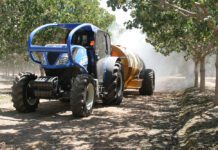
Listen to the audio version of this article. (Generated by A.I.)
One of the most common allegations leveled against agriculture is that children in rural communities, particularly those attending schools near farmland, face serious risks from pesticide exposure. Protests, lawsuits and headlines repeat this message so often that it can seem like fact. If you listened only to the loudest voices, you might think California has no safeguards at all. It is no wonder some parents feel anxious about their children’s safety.
But here is the reality: California has the toughest pesticide regulations, enforcement and monitoring systems in the country, and maybe the world. Growers and regulators work within a system built from the ground up to protect the most vulnerable groups, especially children.
How Pesticides Are Approved
The process begins long before a product ever touches a field. Any pesticide used in California must first be approved by the U.S. Environmental Protection Agency. Approval requires hundreds of studies that take five to seven years to complete. Regulators evaluate both short- and long-term health effects, especially on potential impacts to vulnerable groups like children and seniors, and potential environmental issues like groundwater contamination or harm to wildlife. These studies are reviewed against strict safety standards, and a product cannot be approved if it presents harmful risks to human health or the environment.
Once a pesticide clears the federal process, California requires it to undergo a completely new and comprehensive round of review. The California Department of Pesticide Regulation (DPR) applies even stricter standards than U.S. EPA. Additionally, products that may qualify under California’s Proposition 65 are subject to a 1,000-fold safety factor. This means exposure levels must be 1,000 times lower than the level at which no harm is detected.
California’s review does not rest with DPR alone. Scientists from the University of California system, the Office of Environmental Health Hazard Assessment, the California Air Resources Board and local County Agricultural Commissioners all have a voice in advising and questioning DPR’s registration assessment before a pesticide is approved. Their job is to examine data and question outcomes to ensure every risk is addressed before approval. This entire process can take up to another decade before a pesticide is approved for use in California.

Oversight After Approval
The protections to the health and safety of people and local communities do not stop once a pesticide is registered. The use of pesticides after registration in California is as highly regulated as the registration process itself. Nowhere is this more visible than around schools.
The idea that children in rural schools are being routinely exposed to high levels of pesticides is not supported by data or science. In fact, California has led the nation for more than 25 years in monitoring and regulating the use of pesticides near schools.
Growers must notify schools and childcare centers every year of the products they might use near school grounds within a quarter mile. These notifications include not only the pesticides they plan to apply but also alternatives they might need depending on crop conditions. Schools are then responsible for notifying interested parents.
Restricted-use pesticides are subject to even stricter rules. Growers must obtain a Notice of Intent permit from their County Agricultural Commissioner, which includes site-specific identification numbers for fields within a quarter mile of a school.
Many pesticide applications are prohibited within that quarter mile on weekdays from 6 a.m. to 6 p.m., including aerial spraying, air-blast sprayers, fumigants and most dust applications. Restricted-use pesticides cannot be applied within 36 hours before the start of a school day.
In addition, growers and applicator companies who may apply pesticides within the quarter mile of a school are required to provide training to workers specific to the requirements of the pesticides used around schools’ regulations.
County Agricultural Commissioners are responsible for enforcing pesticide use regulations at the local level. When discussing pesticides used around schools, Melissa Cregan, Fresno County ag commissioner and president of the California Agricultural Commissioners and Sealers Association, noted that to help assure regulatory compliance, when ag commissioners are notified of a planned application within a quarter mile of a school, they proactively reach out to growers and applicators to remind them of the use requirements around schools.
“There is nothing more important to County Ag Commissioners than assuring the safety of children in agricultural settings and communities, and we prioritize pesticide enforcement as part of that safety assurance,” Cregan said.
Schools’ Role in Oversight
The Healthy Schools Act adds another layer of protection. Every school must appoint an integrated pest management (IPM) coordinator responsible for compliance. These coordinators must provide training, notify parents and staff of expected pesticide use, and maintain application records for at least four years. They must post warning signs before and after applications, file annual reports with DPR and publish IPM plans. This ensures transparency and accountability while children are at school.
Monitoring the Air Children Breathe
California’s monitoring system is another critical safeguard. DPR and the Air Resources Board operate a statewide network of air monitors, intentionally placing many of them at elementary schools. The goal is to track pesticide concentrations in the air where children spend their time.
The 2023 results are informative. Over 8,000 samples were tested for 40 different pesticides. More than half showed no detection. 21 chemicals were not detected at all, 11 were found only at trace levels and eight were measured at quantifiable levels. That’s eight samples out of over 8,000.
To understand what this means, we should understand what the terms mean. No detection means no detection at all. Trace detections mean the air monitoring device detected a chemical, but the level was so low that an actual amount could not be determined. Today’s scientific technologies allow detections down to parts per billion or trillion. This translates to detecting a chemical down to one drop from an eyedropper in an Olympic-size pool for parts per billion and one drop in 20 Olympic-size pools for parts per trillion. A quantifiable detection means that the chemical could be identified, which will automatically result in DPR doing additional investigations to determine why there was a detection. However, it does not mean the chemical was above DPR’s health screening level. No detections exceeded DPR’s health screening levels. These levels are designed to protect the most sensitive groups and already include large safety margins. The conclusion is clear: pesticide levels around schools are well below those that could harm children.
New Advances in Transparency
California has added yet another safeguard with its restricted-use pesticide notification system. Parents, teachers and community members can sign up to receive notifications 48 to 72 hours before a restricted-use pesticide application occurs within a square mile of their home, business or school. Parents can receive notifications for their child’s entire travel route both to and from school, as well as at home or at school. This program, focused on the Central Valley and Central Coast, offers families an extra measure of reassurance. No other state offers this kind of advance notification.
The Bigger Picture
Critics will keep claiming that children are at risk, but their claims do not hold up under scrutiny. California has established a comprehensive system of protections that begins with federal review, includes a decade of state scientific assessment, demands extensive compliance from growers and application companies, requires oversight at the school level and ensures safety through real-world monitoring. Each layer targets the most vulnerable populations, especially children.
It is time to stop pretending that growers and regulators are careless or do not care. The facts tell a different story. Growers are required to follow strict rules, regulators enforce them and scientists independently monitor outcomes. The system is transparent, accountable and designed to protect kids first.
The question is not whether California children are safe from pesticides; the question is how long agriculture will have to keep proving this point in the face of repeated and unfounded allegations. From federal approval to state oversight, down to local use enforcement by county ag commissioners, along with continuous air monitoring and public notifications when a restricted-use pesticide is to be applied, every layer of California’s system demonstrates that safety is not an afterthought but the foundation of how pesticides are regulated and used.
The evidence is not abstract; it is data collected in classrooms, on schoolyards and in the air children breathe. Year after year, the results are consistent: California’s children are not being harmed by pesticides. They are, in fact, among the most protected in the world.
Those who continue to claim otherwise are not defending children. They are ignoring science, undermining public trust and misrepresenting the very safeguards that keep communities safe. Californians deserve better than fear campaigns. They deserve the facts. And the facts are clear: California’s children are safe.















